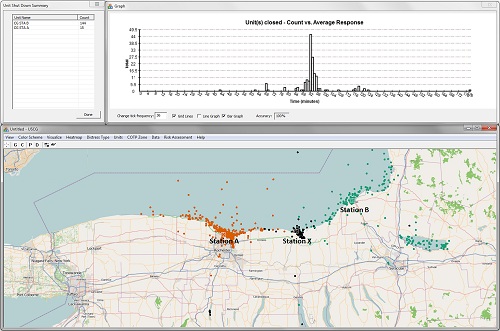ECONOMICS
Computer modeling helps Coast Guard plan search and rescue on Great Lakes
Purdue University has developed a system to analyze the historic response of U.S. Coast Guard search-and-rescue operations in the Great Lakes and assess the potential risks associated with hypothetical changes in the allocation of resources in the region.
The agency is required to stand watch and supervise search-and-rescue cases for mariners in distress. Coast Guard stations provide small boats to respond to search-and-rescue calls, and some of the stations are staffed by volunteers in the Coast Guard Auxiliary.
However, due to attrition of this volunteer service over time, officials need to understand the potential impact of closing any units, said Coast Guard Lt. Comdr. Ben Maule.
The visualization was designed to help Coast Guard analysts assess impacts of hypothetical small-boat station closures on response time, potential lives saved and property lost while highlighting regions that would be exposed to greater risk. It also enables a thorough assessment of all search-and-rescue operations conducted by each Coast Guard station in the Great Lakes region, said David S. Ebert, Silicon Valley Professor of Electrical and Computer Engineering.
"You can simulate who would respond, whether the responding station has enough capacity and visualize the data with color-coded maps," said Ebert, director of the Purdue-led center Visual Analytics for Command, Control and Interoperability Environments, or VACCINE, a U.S. Department of Homeland Security Center of Excellence.
A research paper about the system will be presented during IEEE VisWeekon Oct. 23-28 in Providence, R.I.
"Using visualizations we can see where there is excess capacity and the best resource allocation based on historical search-and-rescue data from the past three years," Ebert said.
VACCINE researchers created the computer-based modeling tool, called Coast Guard Search and Rescue Visual Analytics, which runs on an ordinary computer or laptop. The modeling tool is being used by the Coast Guard's Atlantic Area and Ninth District commands, which are responsible for the agency's oversight on the Great Lakes.
The research paper was written by Ebert; Ross Maciejewski, a former Purdue doctoral student and now an assistant professor at Arizona State University; Purdue doctoral student Abish Malik; and Maule.
"The Coast Guard came to us with five questions," Ebert said. "Instead of just answering those questions, we gave them a system that allows them to continuously ask questions and add new data."
The simulation tool combines advanced visualization methods showing patterns regarding seasonal search-and-rescue patterns and for specific days of the week, time of day and holidays.
The project is ongoing, with researchers working to extend the tool.
"Our results show how our system can be used as an effective risk-assessment tool when examining various mitigation strategies to a known or emergent problem," Ebert said. "Before this system was developed, Coast Guard officials explored possible mitigation strategies, including the implementation of seasonal or weekend-only auxiliary duty stations, but the sheer volume of data and information inhibited the efficient processing of the data."
The agency is required to stand watch and supervise search-and-rescue cases for mariners in distress. Coast Guard stations provide small boats to respond to search-and-rescue calls, and some of the stations are staffed by volunteers in the Coast Guard Auxiliary.
However, due to attrition of this volunteer service over time, officials need to understand the potential impact of closing any units, said Coast Guard Lt. Comdr. Ben Maule.
The visualization was designed to help Coast Guard analysts assess impacts of hypothetical small-boat station closures on response time, potential lives saved and property lost while highlighting regions that would be exposed to greater risk. It also enables a thorough assessment of all search-and-rescue operations conducted by each Coast Guard station in the Great Lakes region, said David S. Ebert, Silicon Valley Professor of Electrical and Computer Engineering.
"You can simulate who would respond, whether the responding station has enough capacity and visualize the data with color-coded maps," said Ebert, director of the Purdue-led center Visual Analytics for Command, Control and Interoperability Environments, or VACCINE, a U.S. Department of Homeland Security Center of Excellence.
A research paper about the system will be presented during IEEE VisWeekon Oct. 23-28 in Providence, R.I.
"Using visualizations we can see where there is excess capacity and the best resource allocation based on historical search-and-rescue data from the past three years," Ebert said.
VACCINE researchers created the computer-based modeling tool, called Coast Guard Search and Rescue Visual Analytics, which runs on an ordinary computer or laptop. The modeling tool is being used by the Coast Guard's Atlantic Area and Ninth District commands, which are responsible for the agency's oversight on the Great Lakes.
The research paper was written by Ebert; Ross Maciejewski, a former Purdue doctoral student and now an assistant professor at Arizona State University; Purdue doctoral student Abish Malik; and Maule.
"The Coast Guard came to us with five questions," Ebert said. "Instead of just answering those questions, we gave them a system that allows them to continuously ask questions and add new data."
The simulation tool combines advanced visualization methods showing patterns regarding seasonal search-and-rescue patterns and for specific days of the week, time of day and holidays.
The project is ongoing, with researchers working to extend the tool.
"Our results show how our system can be used as an effective risk-assessment tool when examining various mitigation strategies to a known or emergent problem," Ebert said. "Before this system was developed, Coast Guard officials explored possible mitigation strategies, including the implementation of seasonal or weekend-only auxiliary duty stations, but the sheer volume of data and information inhibited the efficient processing of the data."

